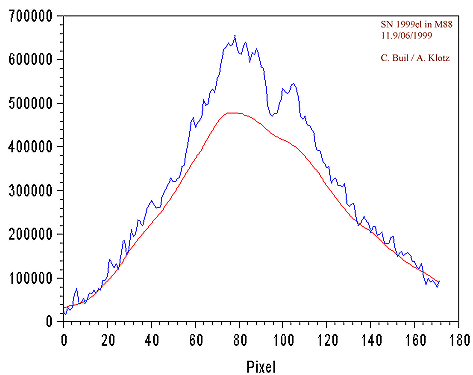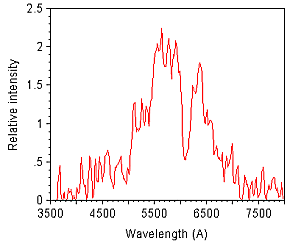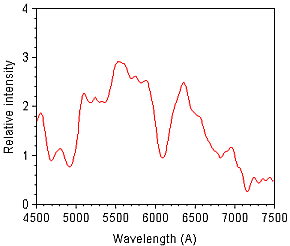SUPERNOVA SN1999cl
The SN1999cl supernova was discovered on May,29 1999 at magnitude 16.4 in the galaxy M88 = NGC 4501 (see circular UAI 7185). This supernova is of Ia type. It appears that its light is strongly absorbed by clouds of dust which redden his radiation. The maximum peak of this supernova is about 3 magnitudes weaker compared to a situation without absorption. He is occurred on about June 8 with magnitude 13.3.
This page is the result of the observation of the spectrum in low resolution of this supernova conducted at Guitalens (UAI 148) by Christian Buil and Alain Klotz with a 8 inch LX200 equipped with a Audine camera in the night from June 11 to June 12, 1999. We used the grating in the convergent beam. This grating was a Rainbow Optics associated with a 3°57 ' prism in order to constitute a Grism (dispersion of 27.15 A/pixel with a CCD KAF-0401E used in binning 1x1).

Figure 1. The two-dimensional spectrum of SN1999cl. The document is the sum of 30 images exposed 80 seconds each and 20 images exposed 120 seconds each, for a total integration time of 1h 20 mn. The supernova is at magnitude 13.3 approximately. It is noted immediately that the supernova spectra is embedded in the galaxy spectra. The silicon line of towards 6100A is definitely perceptible on this document.
A difficulty comes due to the fact that the spectrum of the supernova is spread out over the diffuse and intense background spectrum of the galaxy. The figure 2 shows the profile spectra of SN1999cl (SN + background) and the smoothed profile of the background only, measured on both sides of the supernova spectrum. Note that before calculation of these profiles the natural sky background was subtracted. It is noted that the glare of the subjacent galaxy very strongly modulates the spectrum of the supernova, which accounts for only 30% of the level of the galaxy. It is thus imperative to elimitate very carefully the galaxy spectrum before being able to interpret the spectrum of the supernova correctly.

In blue, raw profile of the supernova and background (transverse binning of 3 pixels). In red, the smoothed average (in order to reduce the noise) background level on both sides of the spectrum of the supernova. Blue wavelength is on the left and the red is on the right.




At top left, the spectrum of the supernova after the subtraction of the background signal of the galaxy. The spectrum is relatively disturbed by the presence of the residual diffuse background of the galaxy. At top right, reduction of the noise in the supernova spectrum by a wavelet-type processing . At bottom left, the spectral response of the instrument obtained by the observation the same night of the star Beta-Leo (Denebola) of spectral type A3V. At bottom right, the final result after division of the uncalibrated spectrum by the response of the instrument. Processed with Iris and VisualSpec.

Comparison of a professional spectrum of SN1999cl taken on June 5, 1999 with our spectrum. The principal features characteristic of an Ia supernova are quite identifiable. It will be noted that this spectrum is notably different from that of SN1999ac and in particular, the deficit from signal in the blue part of the spectrum of SN1999cl, due to the absorption of dust which interposes between this object and us.
|
|
